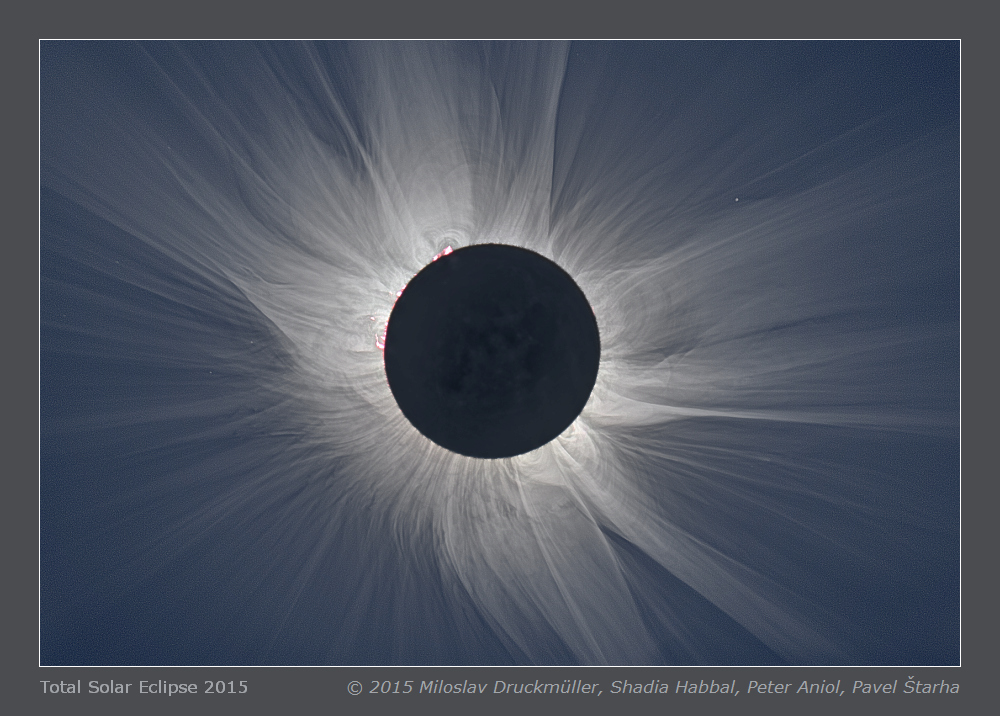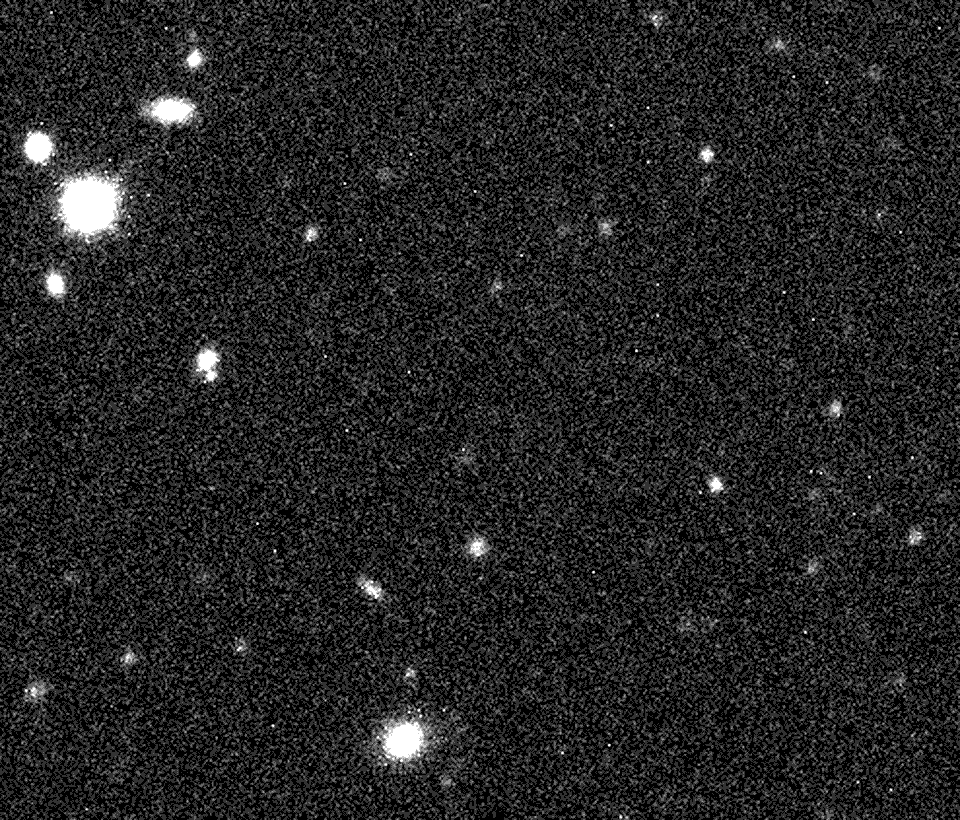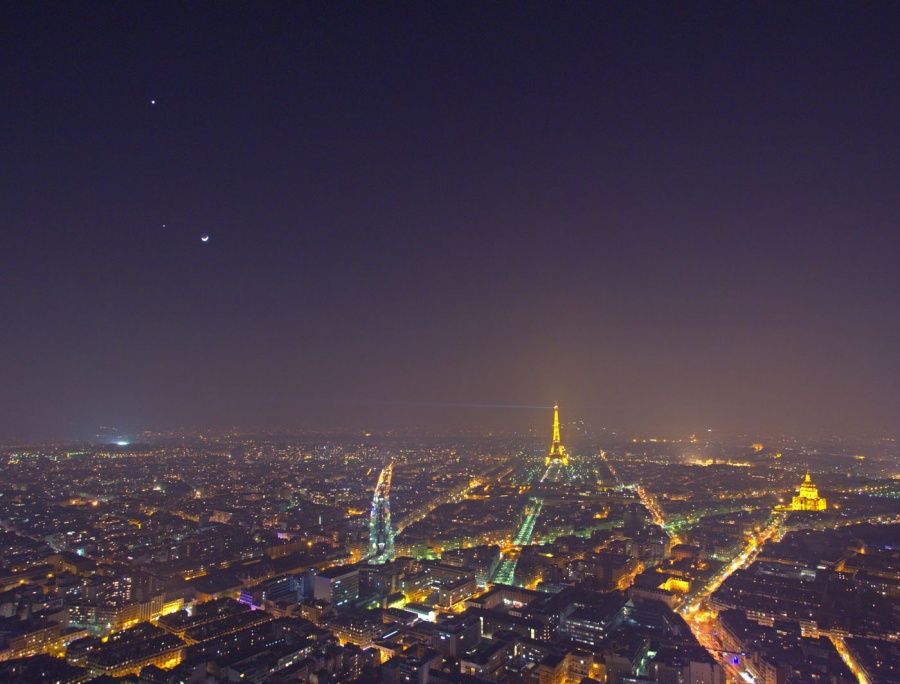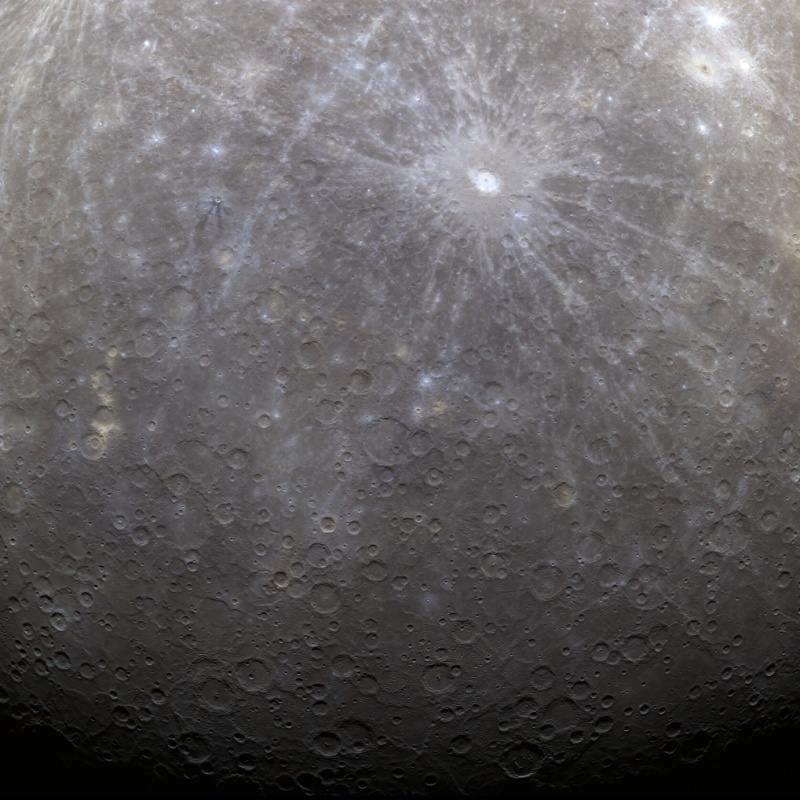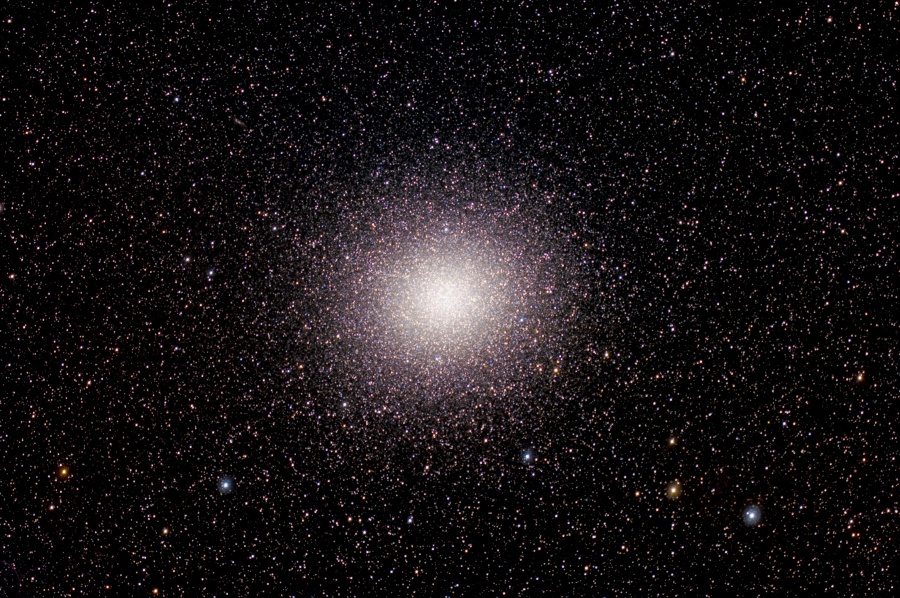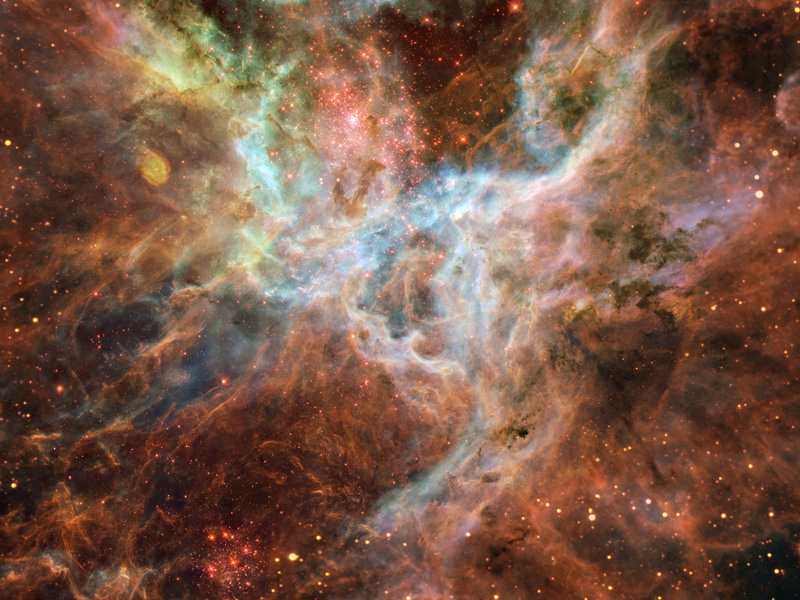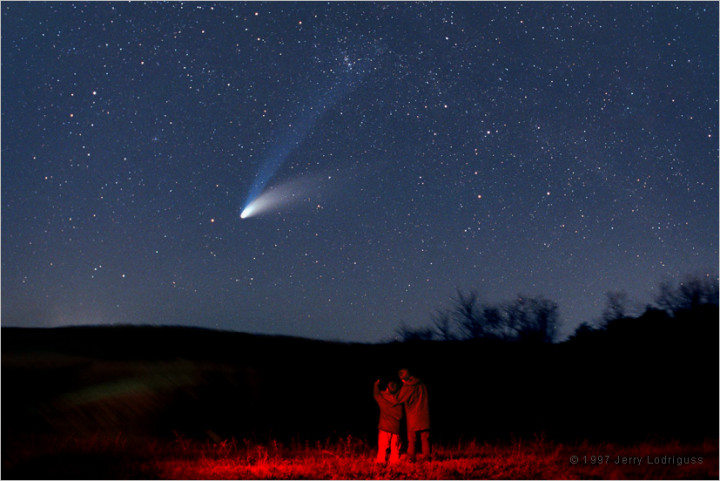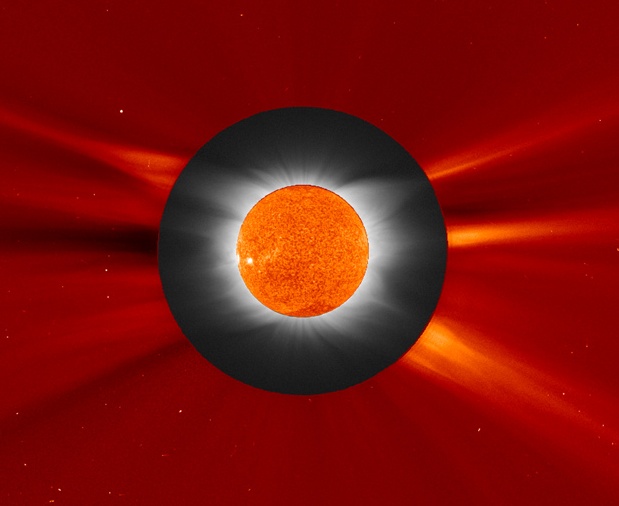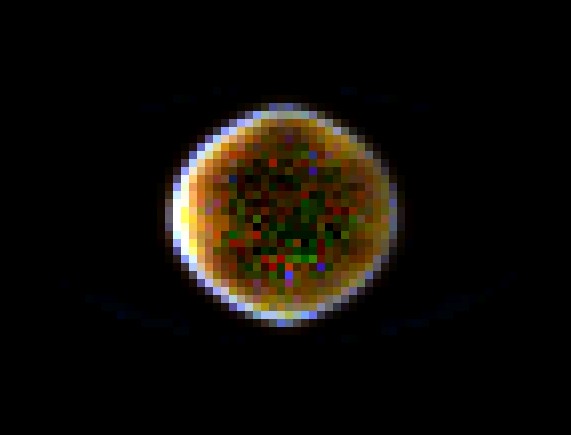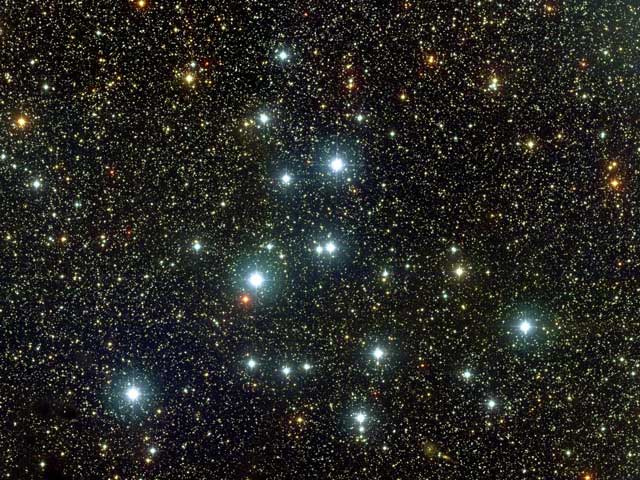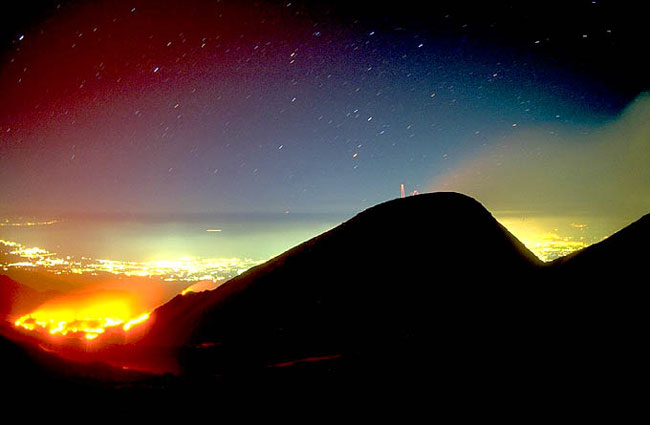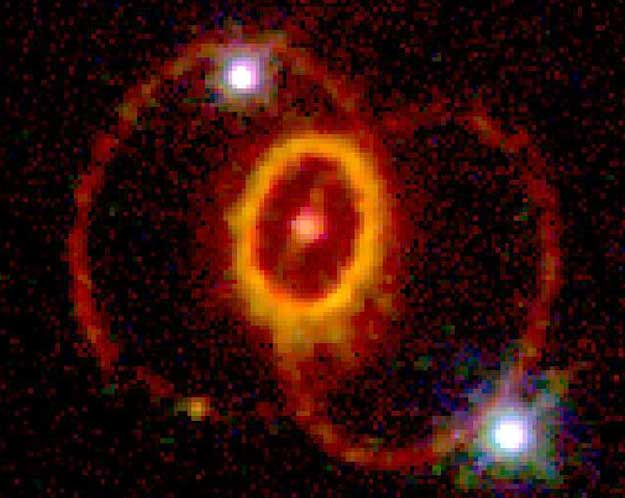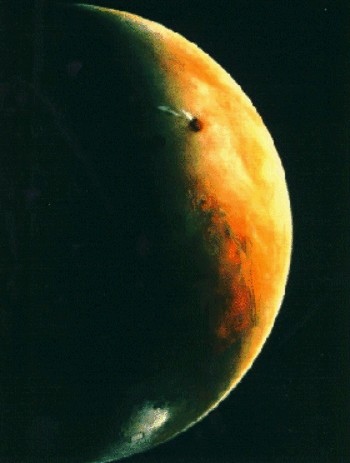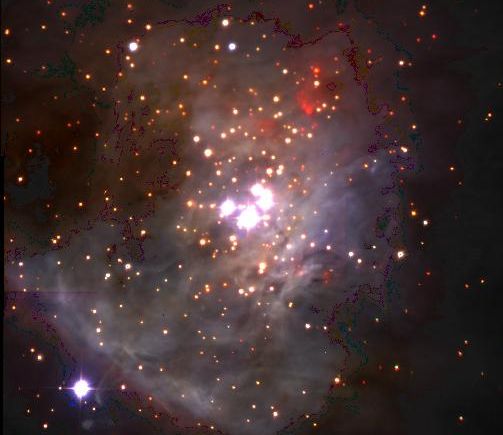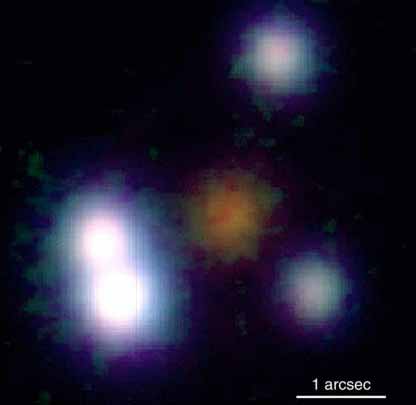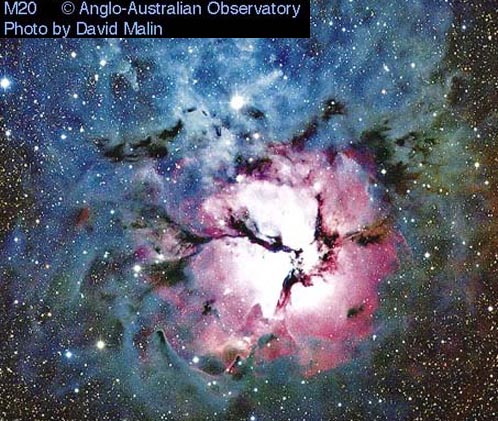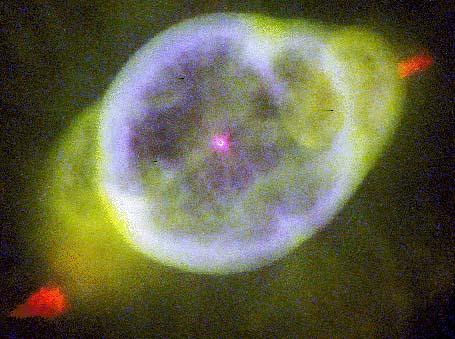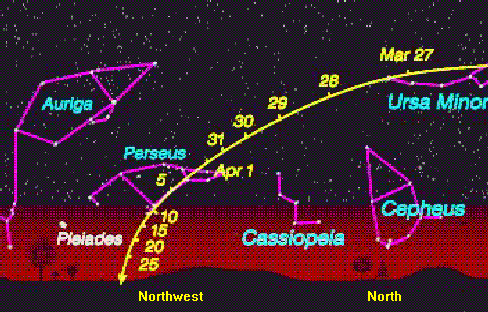| << Previous | Index | Next >> |
2015 During a total solar eclipse, the Sun's extensive outer atmosphere, or corona, is an inspirational sight. Streamers and shimmering features that engage the eye span a brightness range of over 10,000 to 1, making them notoriously difficult to capture in a single photograph. But this composite of 29 telescopic images covers a wide range of exposure times to reveal the crown of the Sun in all its glory. The aligned and stacked digital frames were recorded in the cold, clear skies above the Arctic archipelago of Svalbard, Norway during the Sun's total eclipse on March 20 and also show solar prominences extending just beyond the edge of the solar disk. Remarkably, even small details on the dark night side of the New Moon can be made out, illuminated by sunlight reflected from a Full Earth. Of course, fortunes will be reversed on April 4 as a Full Moon plunges into the shadow of a New Earth, during a total lunar eclipse.
2014 What object has the furthest known orbit in our Solar System? In terms of how close it will ever get to the Sun, the new answer is 2012 VP113, an object currently over twice the distance of Pluto from the Sun. Pictured above is a series of discovery images taken with the Dark Energy Camera attached to the NOAO's Blanco 4-meter Telescope in Chile in 2012 and released last week. The distant object, seen moving on the lower right, is thought to be a dwarf planet like Pluto. Previously, the furthest known dwarf planet was Sedna, discovered in 2003. Given how little of the sky was searched, it is likely that as many as 1,000 more objects like 2012 VP113 exist in the outer Solar System. 2012 VP113 is currently near its closest approach to the Sun, in about 2,000 years it will be over five times further. Some scientists hypothesize that the reason why objects like Sedna and 2012 VP113 have their present orbits is because they were gravitationally scattered there by a much larger object -- possibly a very distant undiscovered planet.
2013
Click to play embedded YouTube video.
Video Credit: Gateway to Astronaut Photography, NASA; Compilation: David Peterson (YouTube);
Music: Freedom Fighters (Two Steps from Hell)
Music: Freedom Fighters (Two Steps from Hell)
2012 Do you recognize the lights of Paris in this picture? In the cityscape taken on March 25 from the top of the 210 meter tall Montparnasse skyscraper, many will spot the looming Eiffel Tower, or the large domed structure of Les Invalides (right), or the colorfully lit elevated Metro train line gently curving toward picture center. You can even pick out the Arc de Triomphe close to the horizon on the right. But regardless of your location, the celestial lights near the western horizon should look very familiar. The lovely triple conjuntion of brilliant Venus (top), Jupiter, and a young crescent Moon was visible in evening skies around planet Earth.
2011 On March 17, the MESSENGER spacecraft became the first to orbit Mercury, the solar system's innermost planet. This is its first processed color image since entering Mercury orbit. Larger, denser, and with almost twice the surface gravity of Earth's moon, Mercury still looks moon-like at first glance. But in this view its terrain shows light blue and brown areas near craters and long bright rays of material streaking the surface. The prominent bright ray crater Debussy at the upper right is 80 kilometers (50 miles) in diameter. Terrain toward the bottom of the historic image extends to Mercury's south pole and includes a region not previously imaged from space.
2010 Featured in the sharp telescopic image, globular star cluster Omega Centauri (NGC 5139) is some 15,000 light-years away and 150 light-years in diameter. Packed with about 10 million stars much older than the Sun, Omega Cen is the largest of 200 or so known globular clusters that roam the halo of our Milky Way galaxy. Though most star clusters consist of stars with the same age and composition, the enigmatic Omega Cen exhibits the presence of different stellar populations with a spread of ages and chemical abundances. In fact, Omega Cen may be the remnant core of a small galaxy merging with the Milky Way.
2009 In the heart of monstrous Tarantula Nebula lies huge bubbles of energetic gas, long filaments of dark dust, and unusually massive stars. In the center of this heart, is a knot of stars so dense that it was once thought to be a single star. This star cluster, labeled as R136 or NGC 2070, is visible just above the center of the above image and home to a great number of hot young stars. The energetic light from these stars continually ionizes nebula gas, while their energetic particle wind blows bubbles and defines intricate filaments. The above representative-color picture of this great LMC nebula details its tumultuous center. The Tarantula Nebula, also known as the 30 Doradus nebula, is one of the largest star-formation regions known, and has been creating unusually strong episodes of star formation every few million years.
2008 Could life exist beneath Enceladus? A recent flyby of Saturn's icy moon has bolstered this fascinating idea. Two years ago, images from the robotic Cassini spacecraft orbiting Saturn led astronomers to the undeniable conclusion that Saturn's moon Enceladus was spewing fountains of gas and ice crystals through cracks in its surface dubbed tiger stripes. Last month, Cassini dove through some of these plumes and determined that they contained water vapor laced with small amounts of methane as well as simple and complex organic molecules. Surprisingly, the plumes of Enceladus appear similar in make-up to many comets. What's more, the temperature and density of the plumes indicate they might have originated from a warmer source -- possibly a liquid source -- beneath the surface. A liquid water sea containing organic molecules is a good place to look for life. Pictured above is a vertically exaggerated close-up of some long, venting tiger stripes. The computer composite was generated from images and shadows taken during recent Cassini flybys. Nine more flybys of Enceladus by Cassini are planned.
2007 Ten short years ago, Comet Hale-Bopp rounded the Sun and offered a dazzling spectacle in planet Earth's night. This stunning view, recorded shortly after the comet's perihelion passage on April 1, 1997, features the memorable tails of Hale-Bopp -- a whitish dust tail and blue ion tail. Here, the ion tail extends well over ten degrees across the northern sky, fading near the double star clusters in Perseus, while the head of the comet lies near Almach, a bright star in the constellation Andromeda. Do you remember Hale-Bopp? The photographer's sons do, pictured in the foreground at ages 12 and 15. In all, Hale-Bopp was reported as visible to the naked eye from roughly late May 1996 through September 1997.
2006
2005 The pixelated planet above is actually our own planet Earth seen in gamma rays - the most energetic form of light. In fact, the gamma rays used to construct this view pack over 35 million electron volts (MeV) compared to a mere two electron volts (eV) for a typical visible light photon. The Earth's gamma-ray glow is indeed very faint, and this image was constructed by combining data from seven years of exposure during the life of the Compton Gamma Ray Observatory, operating in Earth orbit from 1991 to 2000. Brightest near the edge and faint near the center, the picture indicates that the gamma rays are coming from high in Earth's atmosphere. The gamma rays are produced as the atmosphere interacts with high energy cosmic rays from space, blocking the harmful radiation from reaching the surface. Astronomers need to understand Earth's gamma-ray glow well as it can interfere with observations of cosmic gamma-ray sources like pulsars, supernova remnants, and distant active galaxies powered by supermassive black holes.
2004 Lying just at the limit of human perception is a picturesque starfield containing one of the larger open clusters on the northern sky. Spanning an angle larger than the Moon, M39's relatively few stars lie only about 800 light years distant toward the constellation of Cygnus. The above picture of M39 is a mosaic of 33 images taken by the WIYN telescope on Kitt Peak in Arizona, USA. The stars in M39 are all about 300 million years old, much younger than the 5000 million years of our Sun. Open clusters, also called galactic clusters, contain fewer and younger stars than globular clusters. Also unlike globular clusters, open clusters are generally confined to the plane of our Galaxy.
2003 Mt. Etna has been erupting for hundreds of thousands of years. Located in Sicily, Italy, the volcano produces lava fountains over one kilometer high. Mt. Etna is not only one of the most active volcanoes on Earth, it is one of the largest, measuring over 50 kilometers at its base and rising nearly 3 kilometers high. Pictured in 2001 May, the tops of two lava plumes are visible near the center of the frame, while hot lava flowing down the volcano is visible on the left. This panoramic shot also includes the city lights of Calabria and Taormina on the left, and Catania on the right. The Earth's rotation is discernable on this long duration image as star trails. Orange Mars can be seen rising just below the star Antares far in the distance.
2002 What's causing those odd rings in supernova 1987A? In 1987, the brightestsupernova in recent history occurred in the Large Magellanic Clouds. At the center of the picture is an object central to the remains of the violent stellar explosion. When the Hubble Space Telescope was pointed at the supernova remnant in 1994, however, the existence of curious rings was confirmed. The origins of these rings still remains a mystery. Speculation into the cause of the rings includes beamed jets emanating from a dense star left over from the supernova, and a superposition of two stellar winds ionized by the supernova explosion.
2001 "Yes, I have been to Barsoom again ..." begins John Carter in Edgar Rice Burroughs' 1913 science fiction classic "The Gods of Mars". In Burroughs' novels describing Carter's adventures on Mars, "Barsoom" is the local inhabitants' name for the Red Planet. Long after Burroughs' stories were published, Mars continues to inspire Earthdwellers' interests and imagination. Soon it will again be invaded by spacecraft from Earth. This dramatic picture of a crescent Mars was taken by NASA's Viking 2 spacecraft as it approached Barsoom in 1976.
2000 This false-colour image of the young Trapezium star cluster in the Orion Nebula was made with an infrared camera at wavelengths about twice as long as visible light. The infrared data are part of a sensitive survey of this nearby star forming region in which astronomers have identified over 100 extremely low mass objects -- candidates for elusive brown dwarf stars. Brown dwarfs are failed stars with masses so low (about 8% of the Sun's) that they can not sustain nuclear hydrogen burning, a sun-like star's main energy source. While brown dwarfs are thought to be still massive enough to burn deuterium for energy, thirteen of the low mass objects show evidence of lying below even the deuterium burning limit (about 1.3% of the Sun's mass) falling in a range more commensurate with giant planets. These drifting, "free-floating planets" are perhaps as little as 8 times as massive as Jupiter and likely formed along with the cluster stars a million or so years ago. They are detectable in the infrared because they are still hot from formation, but will eventually cool and fade. If the Trapezium is typical of young star clusters, then the survey results suggest that brown dwarfs and free-floating planets may be fairly common, but there are not enough to solve the mystery of dark matter in the Universe.
1999 All four blue images in the above photograph are the same object. The gravitational lens effect of the red, foreground, elliptical galaxy visible near image center creates a cloverleaf image of the single distant quasar. Light from the quasar is pulled around the massive galaxy in different paths, corresponding to different images. Light takes many billions of years to reach us from this quasar. Since light takes a different amount of time to traverse each path, each image shows the quasar as it appeared at a slightly different time in the past, creating time delays on the time scale of days. Since these time delays are influenced by the expansion rate of the universe, analysis of this image helps reveal Hubble's constant, the parameter that calibrates universe expansion. This recent picture by the new Subaru Telescope is perhaps the clearest image yet of this famous optical mirage.
1998
1997 It's a weed, it's Jupiter, no it's - actually planetary nebula NGC 3242. After a star like our Sun completes fusion in its core, it throws off its outer layers it a striking display called a planetary nebula. NGC 3242 is such a planetary nebula, with the stellar remnant white dwarf star visible at the center. This nebula is sometimes called "The Ghost of Jupiter" for its similar appearance to the familiar planet. NGC 3242 is much farther away however, than the measly 40 light-minutes distance to Jupiter. In fact, by comparing the apparent expansion rate with the actual rate determined from Doppler studies, astronomers have estimated the distance to NGC 3242 to be about 1400 light-years away. The red FLIERs visible near the edges of the nebula remain mysterious.
1996 During April Comet Hyakutake heads in toward the Sun after passing the Earth. At this time the comet's orbit places it north of the Earth. Remaining visible in the northern sky as it nears the Sun, it will set progressively earlier in the evening. Early in April, the Moon's glow will diminish viewing of the comet's tail - except during the lunar eclipse on April 3rd! As the comet recedes from the Earth it will appear dimmer even though it is getting intrinsically brighter as it nears the Sun. In late April the intrinsic brightening effect will "win" and the comet will again appear to brighten - possibly getting even brighter than it was last week. At this point the comet will appear near sunset low on the northwestern horizon (see above). So far Comet Hyakutake has exceeded most expectations in brightness and length of tail. If you haven't been impressed by Hyakutake, you probably haven't seen it from a dark location!
| << Previous | Index | Next >> |
